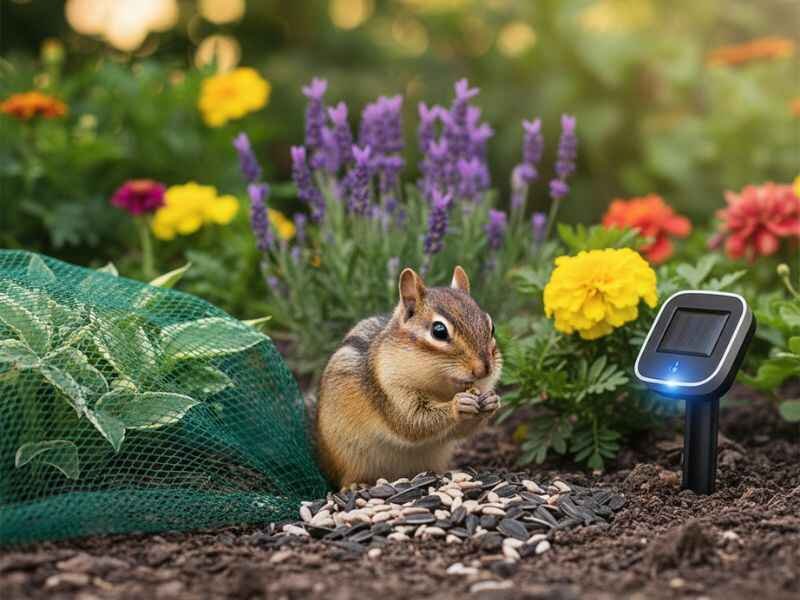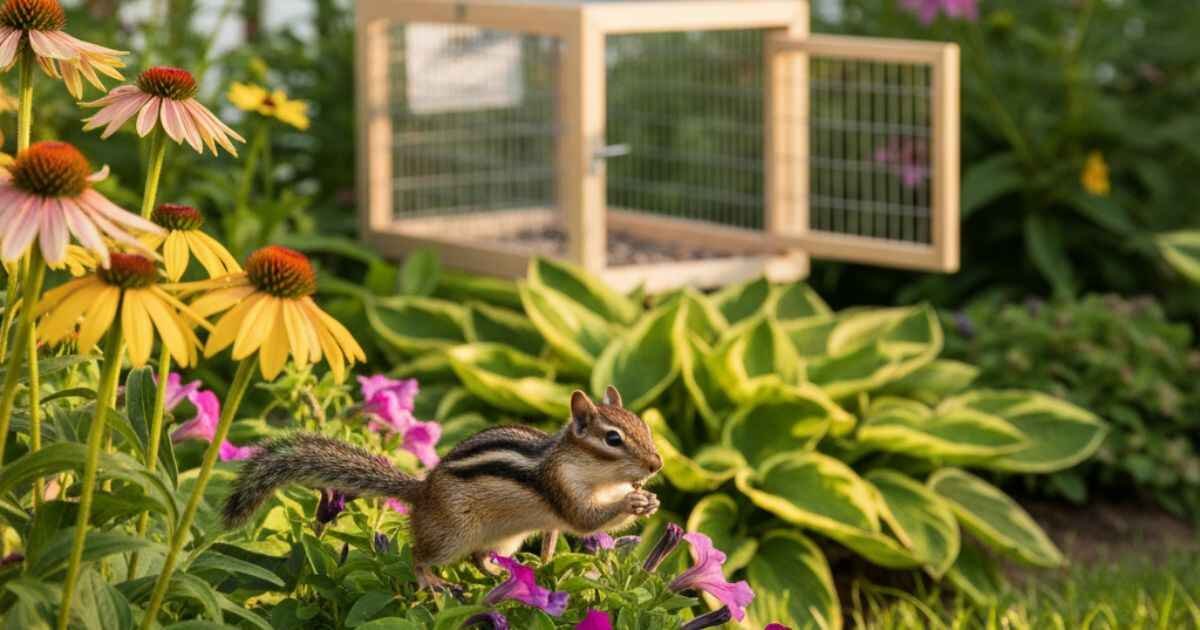Chipmunks are small, furry animals. They look cute and can be fun to watch. But when they dig under your porch or eat flowers in your garden, they can cause problems. Many people want to know how to get rid of chipmunks safely.
This guide will help you learn ways to keep chipmunks out of your yard. You will also learn how to protect your garden and pets. These methods are safe, humane, and easy to try at home.
It is important to act early. Chipmunks dig tunnels that can hurt plants and sometimes your lawn. If you wait too long, they can make a bigger mess. By following simple steps, you can enjoy your yard and garden without worrying about chipmunks.
You will also see tips for using traps, repellents, and natural methods. You can keep chipmunks away without hurting them. By the end of this guide, you will know exactly what to do to protect your yard.
The methods described in this guide are intended for humane chipmunk control. Always handle traps and repellents carefully. Keep children and pets away from traps and chemical repellents. If you are unsure about any technique, consider contacting a professional wildlife control service.
Understanding Chipmunks
Physical Description
Chipmunks are tiny rodents. They are usually brown or reddish. They have stripes on their back and small, round ears. Their tails are long and fluffy. Chipmunks move quickly and can climb small trees.
Habitat
Chipmunks live in forests and gardens. They like places with bushes, rocks, or wood piles. They make small tunnels in the ground called burrows. These burrows can be under patios, sidewalks, or garden beds.
Diet
Chipmunks eat seeds, nuts, fruits, and flowers. Sometimes they dig up bulbs in gardens. They like birdseed too. If you leave food outside, they will find it quickly.
Behavior
Chipmunks are active during the day. You may see them running in your yard or garden. They are shy but curious. Signs of chipmunks include small holes in the ground, chewed plants, and little piles of dirt near tunnels.
Understanding how chipmunks look, where they live, and what they eat helps you plan how to keep them out. You will know when they are nearby and can take action before they make bigger problems.
Identifying Chipmunk Problems
Chipmunks are cute, but they can cause trouble. It is important to know when they are in your yard.
Signs of Infestation
- Small holes or tunnels in the ground.
- Chewed plants or flowers.
- Seeing chipmunks running around your garden.
- Little piles of dirt near burrows.
These signs mean chipmunks are living nearby. You should act fast to stop them from causing more problems.
Potential Damage
Chipmunks can dig up gardens and eat bulbs, seeds, and fruits. They may make small holes in your lawn. Sometimes, they burrow near sidewalks or patios. This can make your yard look messy.
Health Risks
Chipmunks can carry fleas, ticks, and germs. They rarely bite people, but their burrows can sometimes spread parasites to pets. Washing your hands after working in the garden helps you stay safe.
Knowing the signs and problems helps you take action early. You can prevent bigger damage and keep your garden healthy.
Lets Read Our Latest Post: Cant Help Falling in Love Chords for Guitar & Piano Beginners
Humane Methods to Get Rid of Chipmunks

You do not need to hurt chipmunks. There are safe ways to move them out of your yard.
Live Trapping
- Description: Cage traps catch chipmunks alive.
- Baiting Techniques: Put seeds or peanut butter inside the trap.
- Release Protocol: Take the chipmunk far from your home and let it go.
- Pros and Cons: This method is safe and humane. But it takes patience, and you must check traps often.
Bucket Trap Method
- Setup: Make a simple bucket trap with bait at the bottom.
- Baiting: Use sunflower seeds to attract chipmunks.
- Effectiveness: Works well if you place it near burrows.
- Safety: Handle chipmunks carefully with gloves to avoid harm.
Natural Repellents
- Common Repellents: Cayenne pepper, garlic, and peppermint oil.
- Application Methods: Sprinkle around plants or make a spray for the garden.
- Effectiveness: Reapply often, especially after rain.
- Safety: These are safe for kids, pets, and plants.
Ultrasonic Devices
- Functionality: Devices make high-pitched sounds chipmunks do not like.
- Placement: Put them near burrows or garden edges.
- Effectiveness: Can reduce chipmunk visits, but some animals may get used to it.
- Considerations: Avoid placing near birds or small pets if it bothers them.
Using these methods together works best. Start with traps or repellents. Add ultrasonic devices or plant deterrents if needed.
Here’s a simple visual guide to safely remove chipmunks from your yard using humane methods:
Humane Ways to Get Rid of Chipmunks
Live Trapping
Use a cage trap with bait like sunflower seeds or peanut butter. Check traps often and release chipmunks far from your yard.
Bucket Trap Method
Place sunflower seeds in a bucket trap near burrows. Ensure humane handling with gloves when releasing.
Natural Repellents
Use cayenne pepper, garlic, or peppermint oil around your garden. Reapply after rain to keep chipmunks away safely.
Ultrasonic Devices
Install devices near burrows or garden edges. High-frequency sound deters chipmunks but may require combination with other methods.
Safety Tips
- Always wear gloves when handling traps.
- Release chipmunks far from your home.
- Reapply natural repellents after rain.
Following these steps can help you manage chipmunks effectively while keeping them safe and your garden protected.
Preventing Future Infestations
Stopping chipmunks from coming back is important.
Habitat Modification
- Removing Debris: Clear wood piles, leaves, and tall grass.
- Sealing Entry Points: Use cloth mesh or caulk to block holes under patios.
- Landscape Adjustments: Keep plants away from walls and avoid places chipmunks like to hide.
Exclusion Techniques
- Fencing: Small fences keep chipmunks out of gardens.
- Protective Covers: Use mesh over bulbs and plants to stop digging.
- Maintenance: Check fences and covers often and fix any damage.
Deterrent Plants
- Plant Selection: Daffodils, lavender, and alliums are not eaten by chipmunks.
- Planting Tips: Place these plants around the garden edges.
- Additional Benefits: These plants look nice and keep chipmunks away.
Changing your yard and adding barriers makes it harder for chipmunks to return. Use a mix of methods for best results.
You May Like: Genshin Impact’s Upcoming 6.0 Banners
When to Seek Professional Help
Sometimes chipmunks are hard to get rid of on your own. If you try traps, repellents, and other methods but chipmunks keep coming back, it may be time to call a professional.
Signs You Need Assistance
- Chipmunks keep appearing even after you try DIY methods.
- You see many burrows or holes in different parts of your yard.
- Plants, bulbs, or garden areas are damaged repeatedly.
Professional Services
Wildlife control experts can safely remove chipmunks. They use humane traps and relocation methods. Professionals also check for entry points and give advice on preventing future problems.
Cost Considerations
Hiring a professional can cost from $100 to $300 on average, depending on the size of the yard and number of animals. Some services offer packages for ongoing prevention.
Choosing a Service
- Look for licensed and experienced wildlife control companies.
- Read reviews and ask for recommendations.
- Make sure they use humane methods and follow safety rules.
Calling a professional ensures chipmunks are removed safely and your yard stays protected. It is a good option if you have a large infestation or want peace of mind.
Also Read This Post: How Much Is a Nose Job? Real Prices, Risks, and Options
Frequently Asked Questions (FAQ)
Q1: Are chipmunks dangerous to people?
No, chipmunks rarely bite people. They can carry fleas or ticks, so it’s good to wash your hands after gardening.
Q2: Can I keep chipmunks out without traps?
Yes, you can use natural repellents, fences, and deterrent plants. Cleaning up food and debris also helps.
Q3: Is it safe to relocate chipmunks?
Yes, if done carefully. Use gloves and humane traps. Take chipmunks far from your home so they do not return.
Q4: How do I prevent chipmunks from digging in my garden?
Use mesh over bulbs, plant deterrent flowers, and remove hiding spots like wood piles or tall grass.
Q5: Do ultrasonic devices really work?
They can help, but results vary. Some chipmunks may get used to the sound. Combine with other methods for better success.
Q6: Can chipmunks damage my house?
Mostly, they cause damage to gardens and lawns. Rarely, they burrow near foundations, so sealing entry points is important.
Conclusion
Chipmunks can be fun to watch, but they can also make your yard messy. Using humane methods like live traps, bucket traps, natural repellents, and ultrasonic devices can keep them away safely.
Preventing chipmunks is important too. Clear debris, seal entry points, install fences, and plant deterrent flowers. Regular maintenance helps your yard stay chipmunk-free.
If you still see chipmunks after trying these methods, a professional wildlife control service can help. They remove chipmunks safely and prevent future problems.
By taking action early and using the right methods, you can protect your garden, lawn, and home. Your yard can stay beautiful and safe, and chipmunks can be moved without harm.
Start with simple methods, mix strategies, and stay consistent. Soon, your yard will be free from chipmunks, and you can enjoy your garden without worry.
Disclaimer:
The information in this article is for educational purposes only. Always handle wildlife safely and humanely. For large infestations, consult a licensed professional to avoid harm to animals or property.

Alex Taylor is a seasoned writer and editor with over 5 years in digital media, specializing in practical home maintenance guides and homeowner tips. From heating system upkeep to seasonal repair checklists, Alex blends clear, relatable advice with real-world experience to help readers protect their homes and budgets. He personally reviews and fact-checks every article in his areas of expertise to ensure accuracy, clarity, and real-world usefulness. His work also spans tech, culture, fashion, sports, and lifestyle—always with a focus on clarity, relevance, and reader value.
Discover more from Try Hard Guides
Subscribe to get the latest posts sent to your email.

